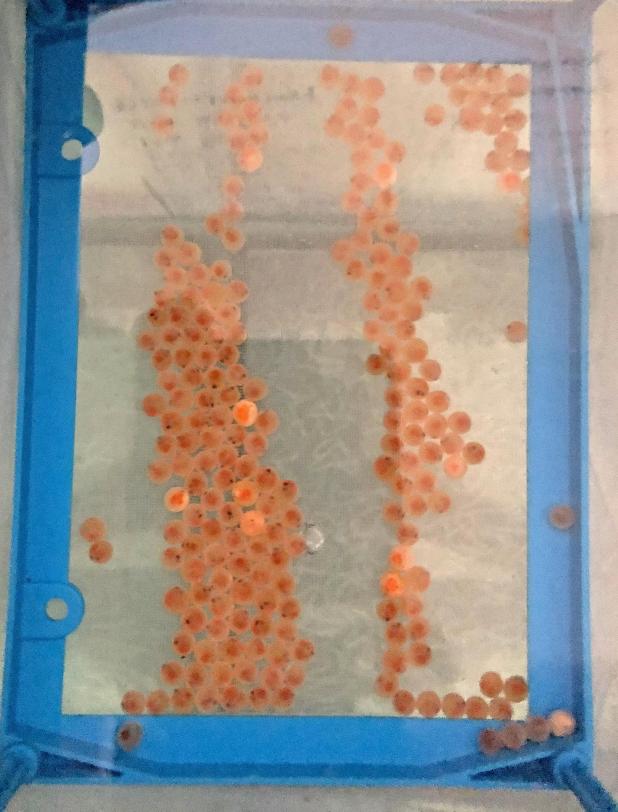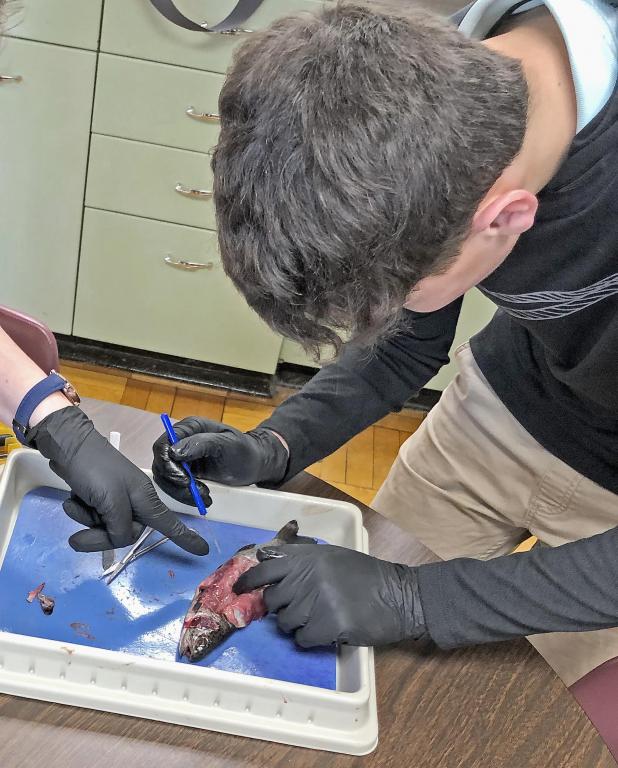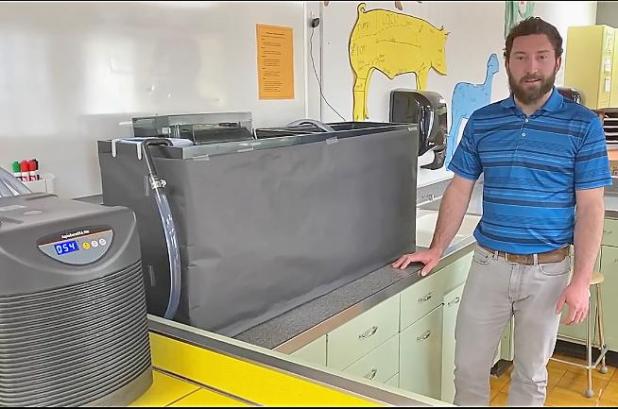
The Intro to Ag classes received these trout eggs on Jan. 15. Students counted 220 eggs in total, and had to remove 15 dead eggs. Inset is a “zoomed-in” view of the eggs.

Freshman Will Long dissects a juvenile trout in Intro to Ag to learn more about the insides and outsides of the fish.

Seth Burge shows off the trout raising equipment, specifically the chiller on the left and the paper-covered tank on the right.
Trout prove perfect catch for natural resource education
Seth Burge’s Intro to Agriculture classes have been participating in the Nebraska Trout in the Classroom Project by raising trout from eggs as part of their curriculum.
Nebraska Game and Parks provides the opportunity for students grades second through 12th to explore aquatic ecosystems, life cycles, water quality and the scientific process through the process of raising trout.
The Nebraska Trout in the Classroom Project is a statewide opportunity that was previously created just for elementary classrooms, and has since expanded to secondary classes.
This is the first time Perkins County Schools will be participating in the project, though Burge has led the project at another school in 2017.
Across both of Burge’s Intro to Ag classes, 20 students are responsible for raising and caring for the trout.
Burge applied for grants to help fund the project and received $1,500 from multiple organizations.
$500 of the funds came from the Perkins County Schools Foundation, and the other $1,000 was from Nebraska Game and Parks, Nebraska Environmental Trust, US Fish and Wildlive Service Sport Fish Restoration Program and Nebraska Trout Unlimited Chapter #710.
The chiller, a refrigerator for the water, was the most expensive part of the setup according to Burge, costing nearly $500. The class also has a 50 gallon tank for use on the project, along with the necessary tools to perform upkeep on the tank and water.
The supplies were ordered during the fall semester, and on January 15 Burge’s classes received the trout eggs.
The students counted 220 rainbow trout eggs in total, and they had to remove 15 dead eggs.
Students were able to identify dead eggs by their color, as a healthy and live egg is orange but the dead eggs are more of a cloudy white color.
In the beginning of the process, the tank had to be wrapped in black paper to help block out light because the eggs are photosensitive to fluorescent lights, and students crafted a hatching basket for the eggs to reside.
Just over 200 of the eggs hatched on January 23, and are currently in the sac fry stage of life.
This means they are in a sac containing the remainder of the yolk, which they feed on.
The Intro to Ag classes are currently working on creating a feeding basket for the fish to go in next. Their next stage of life will be the fry stage, which is when they will begin seeking outside sources of food.
Burge’s students are in charge of testing the water quality, making sure the temperature is what it should be, checking pH and ammonia levels, and more.
Along the way they are learning about the nitrogen cycle, closed systems, and how to monitor things like nitrates to know when water changes are needed.
“They’re raising them and trying to provide them with the best artificial environment that we can,” Burge said.
When the trout grow to the fingerling stage, about one to two inches long, Nebraska Game and Parks will contact the class with information on where the trout can be released.
The fish should be ready to be released sometime in May.
Because trout are non-native to Nebraska, they need to be released in an approved location. Burge guesses this will be in Ogallala or North Platte, but they won’t be sure until the time comes.
The fish will reach adulthood in approximately two years.
To prepare for the project, Burge had his students dissect a trout in the juvenile stage, when the fish are about six inches long.
This way they were able to learn about the internal and external parts of the fish.
Burge wanted to bring this project to Perkins County Schools because the school doesn’t have any classes that are strictly related to natural resources.
To read the full story, subscribe by calling the Tribune at 308-352-4311 or sign up for an e-edition by clicking here.
